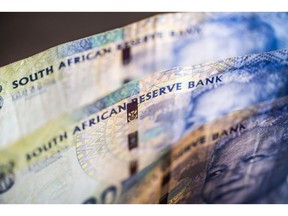Article content
(Bloomberg) — South Africa’s National Treasury is considering withdrawing as much as half of the 497 billion rand ($27.3 billion) of contingency reserves held by the central bank to help reduce the government’s debt load or fund public-sector wages.
The Treasury and central bank are close to agreeing on terms of the draw-down from the Gold & Foreign Exchange Contingency Reserve Account, according to people familiar with the discussions who asked not to be identified as they’re not authorized to discuss the matter publicly.
Article content
The two institutions have been in talks with development finance agencies about establishing best practices and ensuring sufficient buffers remain in place to guard against future potential exogenous shocks, the people said. Details of the withdrawal are expected to be finalized by the time the Treasury presents the annual budget in February, they said.
The Treasury said it’s preparing a response to a request for comment. The central bank declined to comment beyond reiterating Governor Lesetja Kganyago’s confirmation last month that the two institutions are discussing the matter.
Read More: South Africa’s Central Bank Confirms Discussions to Tap Reserves
The withdrawal is being considered as South Africa prepares for elections and at a time when public finances are under significant strain. The government is collecting less revenue because an energy shortage and logistics constraints are curtailing mining and other companies’ profitability. At the same time, the state is facing rising debt-service costs and a growing civil-servant wage bill.
Last month, the Treasury forecast gross debt as a percentage of gross domestic product would peak at 77.7% in 2025-26 — up from a forecast of 73.6% in February. Wages account for about a third of government expenditure.
Article content
Drawing down on the account in a low-growth-trapped economy like South Africa, where spending needs are increasing on an annual basis, offers a short-term fix at a time when a longer-term fix solution is needed, said Jannie Rossouw, professor at Wits Business School at the University of the Witwatersrand.
Once-Off
“It’s a one-off use,” Rossouw said. “What we really need is an investment-friendly government. A government that invests in the economy so that you can have more active economic growth that will grow the tax base so that the government can have more revenue.”
South Africa’s central bank oversees the so-called GFECRA on behalf of the Treasury. The account contains unrealized profit or losses on reserves that are incurred through exchange-rate fluctuations and any gains or losses accrue to the government.
A research paper published on the website of Guido Maia, a PhD candidate in finance at the London School of Economics, argues that the magnitude of the account is unusual by international standards and constitutes “an inefficiently allocated resource: zero-yielding cash liquidity that is not usable, despite being costly to fund.”
Article content
The profits on the account exist on paper unless they are realized by selling the underlying assets, Kganyago told reporters last month, warning that this could diminish the country’s reserves and potentially leave it more vulnerable to future shocks.
Another concern raised about the plan is that a full withdrawal might result in the central bank needing to be re-capitalized by the Treasury, jeopardizing its independence.
The notion that “there is some pot of gold hidden in the Reserve Bank, and all that is needed is to figure out how to get into that pot of gold and bingo, our problems are solved, is very, very simplistic,” Kganyago said on Nov. 23. “At worst, it’s actually very reckless.”
Still, not making use of the account is “not sustainable either,” he said. “There must be an answer in between.”
The Treasury wants to sign off on the proposals before next year’s general election as part of the work of the current administration, so that strict conditions are in place should the new administration want to change course, the people said.
Share this article in your social network

Comments